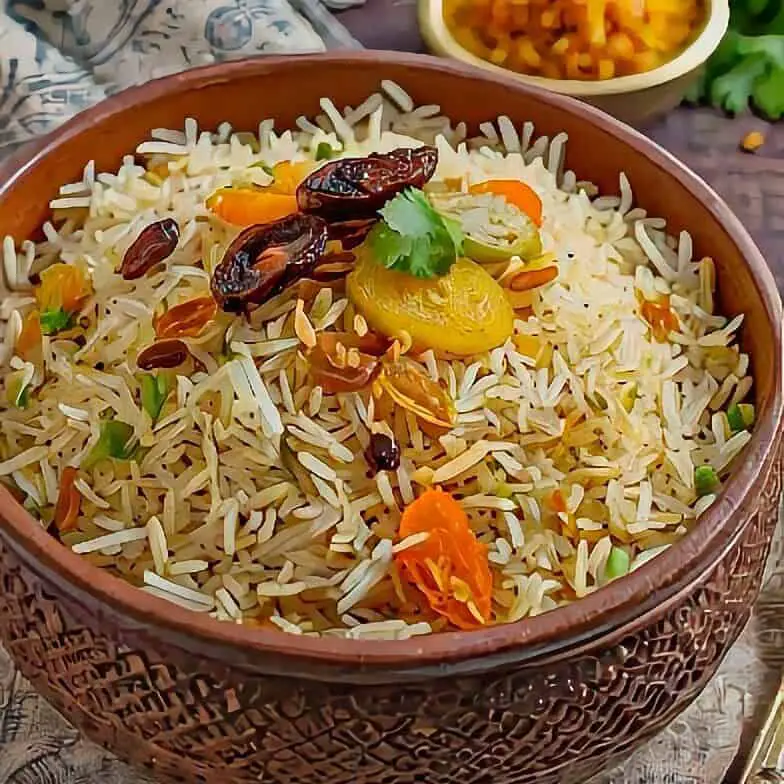Our first try of the Afghani Pulao Rice recipe was on an exploration that led us to a small, bustling restaurant where the became the highlight of our culinary journey. The restaurant we visited was a local gem, offering an authentic taste of Afghan cuisine that truly captured our attention. From the moment we walked in, it was clear that this place was special, not just for its food but also for the warm welcome we received from the locals. The Afghani Pulao Rice recipe, known for its rich and fragrant qualities, was a highlight of our culinary adventure.
The Afghani Pulao Rice recipe we tried was a visual and sensory delight. Served in a large, communal dish, the rice had a golden hue from the saffron, flecked with colourful bits of dried fruit and nuts. Each grain was perfectly cooked, fluffy, and separated, displaying the skill and care that went into its preparation.
The aroma of the rice was inviting, with subtle hints of spices that added depth without overpowering. The dish was complemented by tender pieces of meat, which were marinated and cooked to perfection, adding another layer to the meal.
Experiencing the Afghani Pulao Rice recipe at this restaurant was more than just tasting a dish; it was about connecting with the culture and people of Afghanistan. We had the opportunity to converse with the locals, who shared stories about the significance of the dish in Afghan culture and how it’s traditionally enjoyed during special occasions.
Receiving the recipe directly from them was a meaningful gesture, allowing us to take a piece of Afghanistan back with us. This personal interaction made the meal even more memorable and provided us with a deeper appreciation for the dish.
The Afghani Pulao Rice recipe remains a cherished memory from our trip, not only for its taste but for the connections we made. Every time we prepare it at home, we are reminded of the hospitality we experienced and the rich traditions of Afghan cuisine.
Ingredients For the Afghani Pulao Rice Recipe
Rice:
Canola Pil
Onion
Garlic
Carrots
Raisins
Almonds
Cumin Seed
Black Pepper
Cardamom Pod Shelled
Mutton
Garlic
Cardamom Pods
Coriander Seeds
Black Pepper Corns
Cumin Seeds
Bayleafs
Cinnamon Stick
Salt
Broth:
0nion
0arlic
0innamon Stick
0cardamom Pods
Black Pepper
Cumin Seed
Salt
White Sugar
Paprika
Coriander Seeds
Cloves
Water
Cooking Instructions For the Afghani Pulao Rice Recipe
- Heat the canola oil in a large pot over medium heat.
- Add the chopped onion and minced garlic, and sauté until the onions become translucent.
- Stir in the matchstick carrots, raisins, and slivered almonds, and cook for a few minutes until the carrots start to soften.
- Add the cumin seed, ground black pepper, crushed cardamom seeds, and whole clove. Stir well to combine the spices with the vegetables.
- Add mutton pieces. Sear until lightly browned.
- Prepare a spice bundle by tying together the 8 cloves garlic, black cardamom pod, green cardamom pods, coriander seeds, whole black peppercorns, cumin seeds, cloves, bay leaves, and cinnamon stick in a piece of cheesecloth or a muslin cloth. Add this spice bundle to the pot.
- Pour in enough water to cover the ingredients in the pot. Add salt to taste. Bring the mixture to a boil, then reduce the heat to low, cover the pot, and let it simmer until the mutton is tender and cooked through.
5 Things I Love About Afghanistant Food
Afghan food uses spices like cumin, coriander, and cardamom in a way that enhances the flavor of the dish without overpowering it. I appreciate how the spices complement the ingredients, letting the natural taste of the food shine while still offering a robust flavor.
Rice plays a central role in Afghan cuisine, with dishes like Kabuli Pulao being a great example. The rice is cooked to perfection, fluffy and fragrant, often mixed with meat and vegetables. The combination of textures and flavors, such as the sweetness from raisins or carrots, makes Afghan rice dishes truly special.
Afghan kebabs, especially lamb and beef, are marinated with spices and cooked over an open flame. I love the tenderness of the meat and the smoky flavor it gets from grilling, which adds a depth of taste that is hard to resist.
Afghan bread, like naan, is freshly baked and soft, making it a great side for almost any meal. I enjoy how it’s used to scoop up stews or eaten with grilled meats, offering a simple yet satisfying addition to each dish.
Afghan cuisine combines different textures in its meals. From the soft, fluffy rice to the tender meats and crispy vegetables, the variety of textures adds excitement to every bite. This variety keeps the food interesting and enjoyable.
Essiential Ingredients for Cooking Afghanistan Food at Home
Cumin is a staple spice in Afghan cooking, known for its warm, earthy flavor. It’s commonly used in meat dishes, rice, and stews to add depth and complexity to the food. For example, cumin is a key ingredient in Afghan kebabs, adding a distinct taste to the grilled meat, and it is also used in Kabuli Pulao, the national rice dish.
Cardamom, both green and black varieties, is frequently used in Afghan cuisine to add a fragrant, slightly sweet aroma to dishes. Green cardamom is often found in desserts like firnee, a milk-based pudding, while black cardamom is used in savory dishes, such as stews and pilafs, to bring a smoky undertone.
Lamb is one of the most common meats in Afghanistan and is often marinated and grilled or slow-cooked in stews. It’s a key component of dishes like lamb kebabs and lamb stew (qorma), where the meat is cooked with a variety of spices, including cumin and coriander, to enhance its flavor.
Rice is essential to many Afghan meals, particularly long-grain varieties like basmati rice. It forms the base of dishes like Kabuli Pulao, where it’s cooked with meats, raisins, and carrots, as well as plain rice served alongside stews like korma or qorma.
Yogurt is frequently used in Afghan cooking, both as a base for sauces and as a condiment. It provides a cool, tangy contrast to the rich and spiced dishes. In dishes like mantu (Afghan dumplings), yogurt is drizzled on top to add creaminess and balance the heavier flavors.
Saffron, although used sparingly, adds a luxurious golden hue and subtle flavor to Afghan rice dishes. It’s particularly important in festive dishes like shirin pulao, where rice is flavored with saffron, almonds, and dried fruits for a special occasion.
Garlic is used in almost every Afghan dish, providing a sharp and pungent flavor that complements the spices and meats. It’s common in stews, kebabs, and rice dishes, helping to build a savory base that underpins the more fragrant ingredients like cardamom and cumin.
Important Spices for Afghani Recipes
Cumin is one of the most important spices in Afghan cooking, providing a warm, earthy flavor that enhances a variety of dishes. It is frequently used in meat-based dishes, such as kebabs and stews, where its robust aroma complements the richness of the meat. Cumin is also a key ingredient in rice dishes like Kabuli Pulao, adding depth to the overall flavor profile.
Coriander is another essential spice in Afghan cuisine, known for its slightly citrusy and nutty taste. It is often ground into a powder and added to stews, soups, and meat marinades. Coriander is particularly common in qormas, where it helps balance the richness of the sauce and meat with its fresh, zesty notes.
Cardamom, both green and black, plays a significant role in Afghan recipes. Green cardamom is used to flavor desserts like firnee, a traditional Afghan pudding, while black cardamom is more common in savory dishes, such as stews and pilafs. The sweet and smoky flavors of cardamom add complexity and a fragrant aroma to many Afghan meals.
Turmeric is used widely in Afghan cooking for its bright yellow color and earthy, slightly bitter flavor. It is a key ingredient in many stews and rice dishes, such as Kabuli Pulao, where it provides a subtle spice and beautiful golden hue. Turmeric is also known for its health benefits, making it a staple in everyday Afghan cooking.
Saffron is a prized spice in Afghan cuisine, often reserved for special dishes due to its high cost and distinct flavor. It adds a subtle floral taste and a vibrant yellow color to festive dishes like shirin pulao, a sweet rice dish served on important occasions. Though used sparingly, saffron elevates the flavor and presentation of many Afghan rice dishes.
Cinnamon is used to bring warmth and sweetness to Afghan recipes, especially in rice dishes and desserts. In Kabuli Pulao, cinnamon is often combined with other spices to create a balanced, fragrant dish. It’s also used in Afghan desserts, adding a gentle spice that complements sweet ingredients like dried fruits and nuts.
FAQ For the Afghani Pulao Rice Recipe
Q: What is Afghani Pulao Rice?
Afghani Pulao Rice is a traditional Afghan dish made with basmati rice, meat (usually lamb or chicken), and a mix of spices, often including cardamom, cinnamon, and cumin. The dish is commonly garnished with fried raisins, carrots, and nuts.
Q: What are the key ingredients in an Afghani Pulao Rice recipe?
The key ingredients in an Afghani Pulao Rice recipe include basmati rice, meat (lamb or chicken), onions, carrots, raisins, almonds, and a blend of spices like cumin, cardamom, and cinnamon. These ingredients give the dish its rich flavor and texture.
Q: How is the meat prepared in an Afghani Pulao Rice recipe?
In an Afghani Pulao Rice recipe, the meat is typically browned in oil or butter before being cooked with spices. Once the meat is tender, it is mixed with the rice and other ingredients, ensuring that the flavors are evenly distributed.
Q: Can Afghani Pulao Rice be made vegetarian?
Yes, Afghani Pulao Rice can be made vegetarian by omitting the meat and using vegetable broth instead of meat broth. You can add more vegetables like peas, bell peppers, or beans to enhance the flavor and texture of the dish.
Q: What is usually served with Afghani Pulao Rice?
Afghani Pulao Rice is often served with a side of yogurt or chutney, and sometimes paired with fresh salads or naan bread. The combination of these sides complements the rich flavors of the Afghani Pulao Rice.

Afghani Pulao Rice Recipe
Ingredients
- 1 tablespoon canola oil
- 1 onion chopped
- 3 cloves garlic minced
- 1 cup carrots matchstick cut
- ½ cup raisins
- ½ cup almonds slivered
- 1 teaspoon cumin seed
- 1 teaspoon black pepper ground
- 1 cardamom pod shell removed and seeds crushed into a powder
- 2 ;bs mutton mutton, bone in
- 1 cardamom pod black
- 8 cardamom pods green
- 1 tbsp coriander seeds
- 1 tbsp black pepper corns whole
- 2 bayleafs
- 1 large cinnamon stick
- 2 tbsp salt or to taste
- 1 onion peeled and halved
- 1 garlic whole head loose skins removed
- 1 cinnamon stick
- 4 cardamom pods crushed
- 1 teaspoon black pepper
- 1 teaspoon cumin seed
- 1 teaspoon salt
- 1 teaspoon white sugar
- 1 teaspoon paprika
- 1 teaspoon coriander seeds
- 3 ½ cups water or as needed to cover
Instructions
- a. Heat the pot.
- b. Add the canola oil.
- a. Put in the chopped onion.
- b. Add the minced garlic.
- c. Sauté until translucent.
- a. Add the matchstick carrots.
- b. Add the raisins.
- c. Add the slivered almonds.
- d. Cook until carrots soften.
- a. Add cumin seed.
- b. Add ground black pepper.
- c. Add crushed cardamom seeds.
- d. Add whole clove.
- e. Stir well.
- a. Add mutton pieces.
- b. Sear until lightly browned.
- a. Tie the spices in cheesecloth.
- b. Add the spice bundle to the pot.
- a. Add enough water to cover.
- b. Add salt to taste.
- c. Bring to a boil.
- d. Reduce heat and cover.
- e. Simmer until mutton is tender.
- a. Combine ingredients in a separate pot.
- a. Add water to cover.
- b. Bring to a boil.
- c. Reduce heat and cover.
- d. Simmer for 30 minutes.
- a. Remove the spice bundle.
- a. Strain the broth into the pot.
- b. Mix gently.
- a. Add the rice.
- b. Stir it into the mixture.
- a. Bring to a boil.
- b. Reduce heat and cover.
- c. Cook for 20-25 minutes.
- a. Fluff the rice with a fork.
- b. Let it rest.




1 comment
I couldn’t believe how easy and tasty this recipe turned out to be.
Comments are closed.